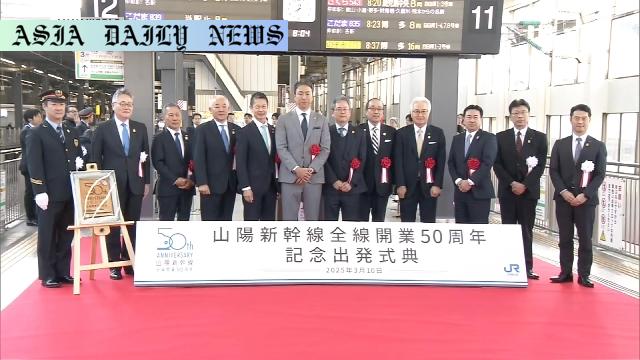Sanyo Shinkansen – A ceremony marks 50 years of impactful bullet train service, revolutionizing travel and economy in Japan.
Sanyo Shinkansen celebrates its 50th anniversary since the full opening in 1975.
The bullet train line significantly impacted tourism, travel time, and business sectors in Hiroshima and beyond.
With the Shinkansen, Tokyo-Hiroshima travel time reduced to under 4 hours.
Hiroshima Governor and notable figures like Kuroda Hiroki participated in the celebration ceremony.

Commemorating 50 Years of the Sanyo Shinkansen
The Sanyo Shinkansen, the iconic bullet train line connecting Shin-Osaka to Hakata, celebrates a monumental milestone – 50 years since its full opening in 1975. The celebration took place in Hiroshima Station, featuring a blend of history, nostalgia, and progress. Over the decades, the Sanyo Shinkansen has played a pivotal role in shaping travel, tourism, and business, particularly in regions like Hiroshima. The train line has become a symbol of technological advancement and convenience in Japan. Notably, March 10, 1975, marks the official date when the Shinkansen began its full service, drastically transforming transportation across the western corridor of Japan.
The ceremony organized by Japan Railway (JR West) was attended by prominent officials, including Hiroshima Governor Yuzaki Hidehiko, railway executives, and former professional baseball player Kuroda Hiroki. Their heartfelt addresses highlighted the deep connection between the bullet train and the region’s growth. Yuzaki emphasized the Sanyo Shinkansen’s far-reaching impact on Hiroshima’s tourism and other economic sectors, while Kuroda shared personal anecdotes that illustrated the cultural and practical significance of the train service. A Hikari train heading to Hakata marked the celebration as it departed amidst a crowd of enthusiastic well-wishers.
Transforming Travel and Bolstering Economies
The Sanyo Shinkansen’s introduction cut travel time between Tokyo and Hiroshima significantly. Prior to the Shinkansen, it took approximately six and a half hours to traverse this route. However, the train’s full service reduced that trip to five hours. Over the years, advancements in technology have pushed this figure even lower, with the current minimum travel time being three hours and forty-three minutes. This reduction has made commuting between key cities more feasible and streamlined, spurring growth in tourism and enabling businesses to expand their reach more effectively. The ripple effect of time savings has reinforced Japan’s reputation as a global leader in efficient and innovative transportation solutions.
Durable and safe operation continues to be a hallmark of the Shinkansen. JR West affirmed its commitment to maintaining safety standards while expressing gratitude to the public for their continued trust. The bullet train’s contributions to local economies are immeasurable, particularly in regions like Hiroshima, where it opened doors to countless opportunities in commerce and leisure. Moreover, upcoming infrastructure developments, such as a new building scheduled to open near Hiroshima Station, aim to further bolster the area’s visibility and accessibility.
A Legacy of Comfort and Innovation
For many, the Shinkansen represents more than just a means of transportation—it is emblematic of modern Japan’s resilience and forward-thinking spirit. Former baseball player Kuroda Hiroki captured this sentiment perfectly during the ceremony, reminiscing about his personal journeys aboard the train during his career. The Shinkansen embodies not only speed and efficiency but also comfort and reliability. This potent combination has cemented its legacy as a world-class travel option that continues to inspire awe among international visitors and local commuters alike.
The celebration at Hiroshima Station was not merely about looking back at a glorious past but also about envisioning a vibrant future. The innovations introduced by the Sanyo Shinkansen over its 50 years of service have paved the way for newer generations of bullet trains, ensuring that Japan remains at the forefront of global transportation technologies. As the train departed amidst cheers and applause, it stood as an enduring symbol of Japan’s commitment to progress and excellence.



Commentary
The Sanyo Shinkansen: An Icon of Innovation
The celebration of the Sanyo Shinkansen’s 50th anniversary is a momentous occasion, not just for Japan but for the world. The bullet train continues to be a marvel of engineering, consistently pushing boundaries and setting new standards for speed, comfort, and safety. When we think of Japan’s most groundbreaking innovations, the Shinkansen undoubtedly tops the list. Its introduction in 1975 symbolized more than just improved transportation—it encapsulated a vision for a more connected, efficient, and prosperous society.
Unmatched Convenience and Economic Impact
One cannot overstate the transformative effect of the Sanyo Shinkansen on regions like Hiroshima. Cutting travel time between major cities and creating a seamless connection across key economic hubs, the train has played a crucial role in boosting local economies. It has opened opportunities not just for tourism but also for businesses seeking to expand their operations. The Sanyo Shinkansen reduced distances and brought people closer together, proving that technological advancements can profoundly influence economic and societal growth.
Looking Toward the Future
As we celebrate this significant milestone, it is also essential to look toward the future of transportation. The impending infrastructure projects near Hiroshima Station reflect a forward-thinking approach to maximizing the potential of this landmark train line. The continual development of the Shinkansen, with improvements in speed and sustainability, ensures that it remains relevant in an increasingly fast-paced world. With global attention on climate change, innovations like efficient train travel will play a critical role in providing greener alternatives to air travel and long-distance commuting.
The Sanyo Shinkansen is not merely a train—it is a legacy of progress, a symbol of connectivity, and a beacon of what’s possible when innovation meets purpose. Congratulations to everyone who made this milestone possible, and may the next 50 years be just as inspiring!